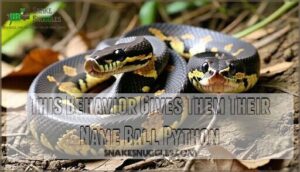This site is supported by our readers. We may earn a commission, at no cost to you, if you purchase through links.
 You’re about to discover some mind-blowing secrets about these African serpents that’ll make you see them in a whole new light.
You’re about to discover some mind-blowing secrets about these African serpents that’ll make you see them in a whole new light.
Ball pythons earned their name by curling into a perfect sphere when threatened – nature’s original stress ball!
These gentle giants can live over 30 years, fast for months without losing weight, and squeeze through gaps smaller than your thumb.
They’re the smallest python species, yet pack incredible strength.
With over 500 color variations called morphs, each snake’s pattern is as unique as a fingerprint.
From their heat-sensing superpowers to their surprising swimming abilities, these fascinating facts reveal just how remarkable ball pythons truly are.
Table Of Contents
- Key Takeaways
- Ball Pythons Are Native to West and Central Africa
- Ball Pythons Are The Smallest of The Python Species
- Ball Pythons Are Known for Their Unique Defensive Behavior
- Ball Pythons Are Excellent Escape Artists
- Ball Pythons Are Nocturnal and Solitary
- Frequently Asked Questions (FAQs)
- What are 5 interesting facts about ball pythons?
- What are 5 interesting facts about pythons?
- Can ball pythons hold sperm?
- Can a ball python swim?
- What are some fun facts about ball python?
- What are 10 facts about pythons?
- What makes a ball python special?
- What is unique about pythons?
- How often should ball pythons be handled?
- Are ball pythons suitable pets for children?
- Conclusion
Key Takeaways
- You’ll discover that ball pythons earned their name by curling into perfect spheres when threatened, creating nature’s original stress ball while protecting their vulnerable heads and organs.
- You can expect these gentle giants to live over 30 years and reach only 3-5 feet in length, making them the smallest python species and ideal pets compared to their massive cousins.
- You’ll be amazed by their escape artist abilities – they can squeeze through gaps smaller than your thumb and will exploit any tiny opening in their enclosure, so you’ll need bulletproof security measures.
- You’ll find they’re nocturnal loners who prefer living alone, communicate through scent trails and body language, and can fast for months without losing weight while maintaining their strength.
Ball Pythons Are Native to West and Central Africa
If you’ve ever wondered where ball pythons come from, you’ll find their wild relatives living across West and Central Africa in countries like Ghana, Nigeria, Togo, and Benin.
These adaptable snakes make themselves at home in savannas, grasslands, and scattered forests where they can find the perfect mix of shade and open hunting grounds, which is a key factor in their ability to thrive in areas with the perfect mix of shade.
Ball pythons are masters of adaptation, effortlessly blending into diverse African landscapes from sun-drenched savannas to shaded forest floors.
Found in Countries Like Ghana, Togo, Benin, and Nigeria
Picture yourself exploring the heart of West and Central Africa, where ball pythons – also called West African Pythons – call home.
These incredible snakes thrive across Ghana, Togo, Benin, and Nigeria, playing vital roles in their regional ecosystems.
In Nigeria, they hold deep cultural significance among the Igbo people, who consider them sacred creatures.
However, these pythons face challenges from habitat loss and collection for the pet trade.
Export regulations help protect wild populations, while conservation efforts work to maintain healthy numbers in their native range.
Thousands are exported annually, making responsible sourcing essential for preserving these amazing reptiles in their African homeland.
Their adaptability is evident in their preference for savanna and grasslands.
Inhabit Savannas, Grasslands, and Forests
Beyond their specific country locations, ball pythons showcase remarkable adaptability across diverse African Ecosystems.
These clever serpents don’t just pick one type of home—they’ve mastered living in multiple environments throughout West and Central Africa.
Their natural habitat spans three main landscape types:
- Savannas – Open grasslands with scattered trees where they hunt rodents
- Grasslands – Rolling plains that provide excellent camouflage opportunities
- Forests – Wooded areas offering shelter and abundant prey
This Habitat Variation demonstrates their impressive Climatic Adaptations.
Their Wild Diet remains consistent across these environments, while their Regional Distribution proves they’re nature’s ultimate homebodies—just with multiple addresses!
Ball Pythons Are The Smallest of The Python Species
When you think of pythons, you might picture massive snakes that could wrap around a small car, but ball pythons break that stereotype completely.
These compact reptiles max out at just 3-5 feet long, making them the smallest members of the python family and perfect for people who want a python without needing a garage-sized terrarium.
Average Adult Size is 3-5 Feet Long
When fully grown, ball pythons reach a modest adult size of 3-5 feet, making them perfect for size comparisons with other python species.
Sexual dimorphism plays a role here—females typically outgrow males by several inches and pounds.
Their compact dimensions mean you won’t need massive enclosure size requirements like their giant cousins.
Size variations between individuals reflect genetics and captive growth conditions.
As hatchlings, they typically weigh between 50-80 grams.
These pocket-sized pythons prove good things come in small packages.
Hatchlings Are Only 10-16 Inches Long
When ball pythons first hatch, they’re incredibly tiny at just 10-16 inches long.
These miniature serpents look like perfect copies of their parents, just pocket-sized.
Their small stature makes hatchling care more delicate since they’re vulnerable to temperature changes and predators.
Here’s what makes baby ball pythons special:
- Bright coloration that fades with age
- Independent from day one
- Growth rate varies by feeding schedule
- Smallest python species babies worldwide
Males Are Typically Smaller Than Females
Sexual dimorphism in ball pythons creates fascinating size differences between males and females.
Males typically reach 2-3 feet, while females grow to 3-5 feet – that’s quite the gap!
This isn’t just random; genetic influence and different growth rates determine these variations.
The smaller males actually have a size advantage during mating, as they can easily maneuver around larger females.
These breeding implications showcase how sex determination affects adult size, making ball python biology truly remarkable to observe.
Ball Pythons Are Known for Their Unique Defensive Behavior
When you encounter a stressed or frightened ball python, you’ll witness their famous defensive move that earned them their name – they curl up into a tight, perfect ball to protect their head and essential organs.
You’ll also hear them hiss loudly like a deflating balloon, which might sound scary but is actually just their way of saying "please leave me alone" without any real aggression.
This Behavior Gives Them Their Name Ball Python
When threatened, ball pythons perform their signature defensive coiling move that earned them their name.
These remarkable snakes curl into perfect balls faster than you can blink, creating an impenetrable fortress of pure muscle and scales.
They tuck their head inside and curl into a tight ball, creating an impenetrable fortress of muscle.
This defense mechanism protects their vulnerable head while presenting only thick scales to predators.
Here’s what makes this defensive behavior so remarkable:
- Their coiling mechanics happen in seconds, faster than you can blink
- This predator deterrent works against snakes, birds, and mammals
- The stress response triggers automatically when they feel unsafe
- Their instinctive coiling response can last for hours until danger passes
- Young Ball Pythons perfect this skill through practice and experience
They Also Hiss Loudly to Scare Off Predators
When threatened, these serpent-superstars release a defensive repertoire that’s both impressive and effective.
Their hissing serves as an audible warning system, creating a loud whooshing sound that can startle even experienced handlers.
This defensive behavior is essential for predator avoidance since ball pythons aren’t built for speed.
Snake communication through hissing represents one of nature’s unique defensive displays, complementing their famous balling technique and body language cues.
Ball pythons hiss to communicate stress, and define their territory as well.
| Hissing Purpose | Defensive Mechanisms |
|---|---|
| Warn predators away | Sound intimidation |
| Signal stress/discomfort | Territory protection |
| Communicate boundaries | Last resort before striking |
Ball Pythons Are Excellent Escape Artists
If you’ve ever wondered how your pet snake seems to vanish from what looked like a secure enclosure, you’re witnessing their natural talent for escape.
Ball pythons can squeeze through gaps that seem impossibly small, sometimes as narrow as half their body width, which means even tiny openings in their habitat can become doorways to freedom.
Have The Ability to Squeeze Through Very Small Spaces
Surprisingly, these escape artists can squeeze through spaces much smaller than their body width.
Your ball python’s incredible body flexibility lets them compress their ribs and flatten themselves like pancakes.
They’ll exploit any opening, no matter how tiny it seems, even a gap the size of a quarter becomes an escape route through their amazing squeezing mechanics and wild survival adaptations.
Understanding their motivation, such as instinctual hunting behaviors, is key to preventing escapes and requires awareness of their amazing squeezing mechanics.
Enclosures Must Be Secure to Prevent Escapes
Think of your ball python as Houdini with scales – these escape artists will find every weakness in their habitat.
Creating escape-proof enclosures requires serious attention to python safety and habitat security.
Here’s your essential checklist for bulletproof enclosure materials:
- Install secure locking mechanisms on all doors and access points
- Seal any cracks or gaps larger than half your snake’s body width
- Choose appropriate enclosure size with tight-fitting, weighted lids
- Use escape prevention clips or clamps on screen tops
- Regularly inspect for wear and potential escape routes
Owners should consider investing in an escape proof enclosure for added security.
Ball Pythons Are Nocturnal and Solitary
If you’re a night owl yourself, you’ll relate to ball pythons since they’re most active when the sun goes down and prefer catching their Z’s during daylight hours.
Unlike social media influencers who crave attention, these snakes are total loners who’d rather live alone and communicate through subtle body language and scent trails instead of chatty conversations, preferring to use subtle means to convey their intentions.
Most Active at Night, Resting During The Day
You’ll find ball pythons are truly nocturnal creatures, becoming most active at night when they hunt for prey.
During daylight hours, they conserve energy by resting in burrows or under logs.
Their sleep patterns remain consistent in captivity, though some adapt slightly to their owner’s schedule.
Consider low-level nighttime illumination for nocturnal viewing.
This nocturnal hunting behavior helps them avoid daytime predators while maximizing successful catches.
Prefer to Live Alone, Not in Pairs or Groups
Ball pythons are nature’s introverts – they genuinely prefer the single life! These snakes evolved as solitary creatures because sharing space creates unnecessary stress.
In the wild, territorial behavior prevents resource competition and reduces social stressors.
Solitary Benefits include:
- Reduced stress from social behavior conflicts
- Better feeding without competition
- Natural territorial instincts remain intact
- Lower disease transmission risks
- Captivity considerations mirror wild solitary living needs
Communicate Through Body Language and Scent
While these solitary creatures prefer living alone, they’ve mastered silent communication through body language and scent marking.
You’ll notice their tail vibrations, head movements, and defensive postures reveal mood and intentions.
Through pheromone release, they leave chemical messages about territory and reproductive status.
This communication complexity proves that even loners need ways to "talk" when necessary.
Frequently Asked Questions (FAQs)
What are 5 interesting facts about ball pythons?
You’ll discover these African natives curl into perfect balls when scared, making them unique among pythons.
They’re surprisingly small at just 3-5 feet, live 40 years, and communicate through scent trails and body language.
What are 5 interesting facts about pythons?
Pythons breathe with their mouths full while eating, travel just 1 mph, and curl into perfect defensive balls. They’re excellent escape artists with over 100 teeth, yet remain completely harmless to humans.
Can ball pythons hold sperm?
Female ball pythons can store sperm for up to seven years after mating.
You’ll find this remarkable ability lets them delay fertilization until conditions are perfect for laying eggs and raising healthy offspring.
Can a ball python swim?
Yes, ball pythons can swim.
You’ll often find them taking a dip in their natural African habitat to cool down on hot days.
They’re surprisingly comfortable in water and enjoy soaking.
What are some fun facts about ball python?
Ball pythons curl into tight balls when scared, giving them their name. You’ll find they’re Africa’s smallest pythons, have over 100 teeth, breathe with mouths full, and travel just 1 mph!
What are 10 facts about pythons?
Like nature’s living rope, these serpents weave fascinating stories.
You’ll discover they’re Africa’s smallest python species, curling into defensive balls when threatened.
They’re nocturnal hunters with 100+ teeth, living 40 years, and breathing while swallowing prey whole, which makes them quite fascinating.
What makes a ball python special?
You’ll find ball pythons curl into perfect spheres when stressed, earning their name.
They’re Africa’s smallest python species, reaching only 3-5 feet, making them ideal pets with their docile nature and impressive 40-year lifespan.
What is unique about pythons?
Pythons are unique because they’re non-venomous constrictors that can unhinge their jaws to swallow prey whole.
You’ll find they can breathe while eating and detect heat through special sensors in their lips, which makes them unique.
How often should ball pythons be handled?
Gentle giants get grumpy with too much grabbing.
You’ll want to handle your snake 2-3 times weekly for 10-15 minutes each session.
This builds trust without stressing them out—happy pythons make better pets.
Are ball pythons suitable pets for children?
Ball pythons can make suitable pets for children with proper adult supervision.
They’re docile, rarely bite, and move slowly at just 1 mph.
However, kids need help with feeding schedules and handling techniques.
Conclusion
Imagine watching your ball python effortlessly slip through a gap you’d swear was too small – that’s the magic these incredible creatures possess daily.
These 26 cool facts about ball pythons reveal why they’ve captured hearts worldwide, from their decades-long lifespans to their rainbow of morphs.
You’ve discovered what makes these African natives truly special, whether you’re considering your first snake or you’re already a python enthusiast, these fascinating reptiles continue proving they’re nature’s most remarkable gentle giants.












